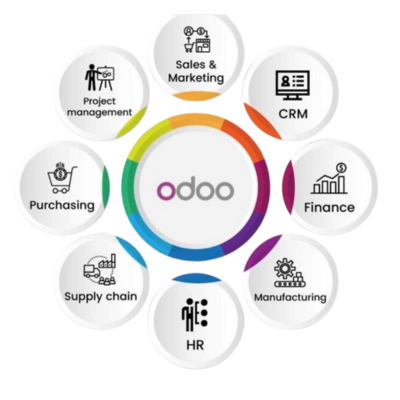In Odoo 18, creating and managing security groups, along with carefully setting access rights, are fundamental to maintaining data security and controlling user access within a business environment. As a comprehensive enterprise resource planning (ERP) platform, Odoo empowers companies to organize access for various users across multiple applications, modules, and data fields. In this article, we’ll dive into the specifics of how to create security groups and manage access rights in Odoo 18, as well as explore why this is essential for companies aiming to secure their operations.
Introduction to Security Groups and Access Rights in Odoo 18
Odoo’s user management system is based on a hierarchy of permissions defined through security groups. Security groups are essential for determining which users can access which areas of the system, and they play a crucial role in ensuring that only authorized personnel have access to sensitive data. By creating security groups, administrators can specify the access levels and functionalities available to various employees, from basic access to critical modules.
In Odoo, managing access rights through security groups is crucial for companies, especially those working with an Odoo development company. From entry-level access to executive permissions, businesses can control which employees have access to which applications, ensuring that sensitive information is only viewable by the relevant parties. Effective management of access rights allows organizations to safeguard data, streamline workflows, and improve user productivity.
Supercharge Growth with Odoo Experts!
Tailored Odoo Solutions for Streamlined Business Efficiency and Growth

Understanding Security Groups in Odoo 18
Security groups in Odoo act as collections of permissions that define a set of roles or access levels. Each security group is assigned specific permissions across various modules, applications, or fields within the system. For instance, one group might have access to the sales module but not to the accounting module, while another group might have full administrative rights across the system.
The process of setting up security groups typically involves:
- Defining User Roles: Administrators must decide the levels of access required for different employee roles. For instance, managers might need full access to certain modules, while entry-level employees require only limited access.
- Creating Security Groups: Within Odoo’s settings, you can create groups to define these roles. These groups can then be linked to modules and functionalities to control access.
- Assigning Users to Groups: Users are then assigned to the appropriate security group, granting them access to the relevant parts of the platform.
By using security groups, Odoo consultants can assist organizations in fine-tuning who has access to specific features and data, ensuring that users interact with the platform in ways appropriate to their roles.
How to Create Security Groups in Odoo 18
Creating security groups in Odoo 18 is relatively straightforward. Here’s a step-by-step guide to help you through the process:
- Navigate to Developer Mode: To manage security settings in Odoo, you need to activate Developer Mode. This option unlocks additional configuration options, including security settings.
- Access the Groups Menu: In Developer Mode, go to Settings > Users & Companies > Groups. Here, you can view the existing security groups and create new ones if necessary.
- Create a New Group: Click “Create” to define a new group. Name the group appropriately to make its role and permissions clear.
- Assign Access Rights: Once the group is created, you’ll need to specify its access rights. Odoo provides access control lists (ACLs) and record rules that allow fine-grained control over which modules, records, and fields each group can access.
- Link the Group to Modules: Finally, link the security group to specific modules, applications, or fields. For instance, a sales team group can be granted access only to sales-related modules while being restricted from the accounting module.
After creating a security group, you can assign users to it by going to the user profile settings and selecting the appropriate group. This streamlined process enables administrators to manage access rights effectively and safeguard data from unauthorized access.

Managing Access Rights with Odoo 18
In addition to security groups, access rights in Odoo 18 allow for more precise control over what users can do within a module. These rights can specify whether a user can read, create, write, or delete records in each module. Access rights management becomes essential, especially when businesses use Odoo custom development services to extend Odoo functionalities tailored to specific needs.
Setting Up Access Rights for Users
Odoo provides administrators with a set of predefined access rights within each module, but these rights can be customized based on the security group assigned to a user. Here are the four primary types of access rights that can be configured:
- Read Access: Grants permission to view records within a module.
- Create Access: Allows the user to create new records.
- Write Access: Provides permission to modify existing records.
- Delete Access: Enables the deletion of records within the module.
Access rights are configured using access control lists (ACLs) in Odoo, which can be adjusted to suit the specific needs of a company. This fine-tuning of access rights ensures that employees can access only the functionalities and data necessary for their roles, protecting sensitive information from being viewed or edited by unauthorized individuals.
Get expert help with Odoo!
Boost efficiency with expert Odoo consulting today!

The Role of Record Rules in Odoo 18
Beyond ACLs, record rules offer another layer of security by defining which records within a model are accessible to users within a security group. For example, an organization might grant all sales team members access to the sales module but restrict them from viewing certain records related to strategic partnerships.
With record rules, companies can apply conditions to determine visibility based on the user’s group membership, providing additional control. This granular approach can be particularly beneficial for businesses seeking advanced security configurations, especially those leveraging odoo consulting services or odoo custom development to design custom workflows and security protocols.

Creating and Applying Record Rules
Creating record rules requires access to Developer Mode and involves the following steps:
- Define the Model: Choose the model to which the record rule will apply. For instance, you might choose sale.order if you want to restrict access to specific sales records.
- Specify Domain Rules: Using domain expressions, define the conditions under which the records will be visible to the group. For instance, a domain rule could be defined to allow access only to records created by the logged-in user.
- Assign to Groups: Finally, assign the record rule to the relevant security group to ensure it applies to the right users.
Record rules offer a powerful way to protect sensitive data, and an Odoo development service can help tailor these rules for maximum security and functionality.

Best Practices for Managing Security Groups and Access Rights in Odoo
Successfully managing security groups and access rights in Odoo 18 involves a few best practices to ensure robust data security and efficient operations:
- Use Principle of Least Privilege: Limit access rights to only what users need to perform their jobs. Avoid granting broader permissions than necessary.
- Regularly Review Access Levels: Periodically review and update user access levels to ensure they align with job responsibilities, especially after role changes.
- Document Custom Access Rules: When implementing custom access configurations, maintain documentation to ensure transparency and simplify future updates.
- Collaborate with Odoo Experts: Consulting with an Odoo consulting company or engaging odoo custom development services can help streamline the configuration process and ensure security best practices.
Expert Odoo ERP Solutions Provider
Hire Expert Odoo Developers for Tailored ERP Solutions Today!

Conclusion
Creating security groups and managing access rights are crucial tasks in Odoo 18 that help companies maintain data security, streamline operations, and foster productive workflows. By setting up well-defined security groups, using access control lists, and applying record rules, organizations can confidently manage user permissions. Whether implemented by an internal team or with the help of an odoo consultant, these security measures provide a flexible yet robust approach to managing sensitive business data.
For businesses seeking specialized solutions, working with the best odoo development company ensures the effective design and implementation of security measures tailored to specific needs. With the right configuration, Odoo 18 can become an invaluable tool for secure, efficient, and scalable operations.














